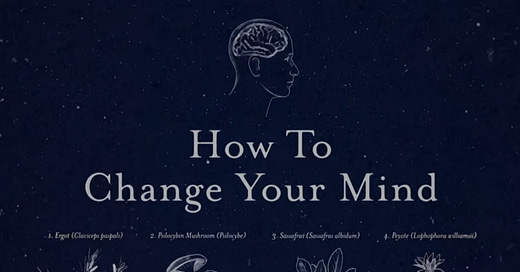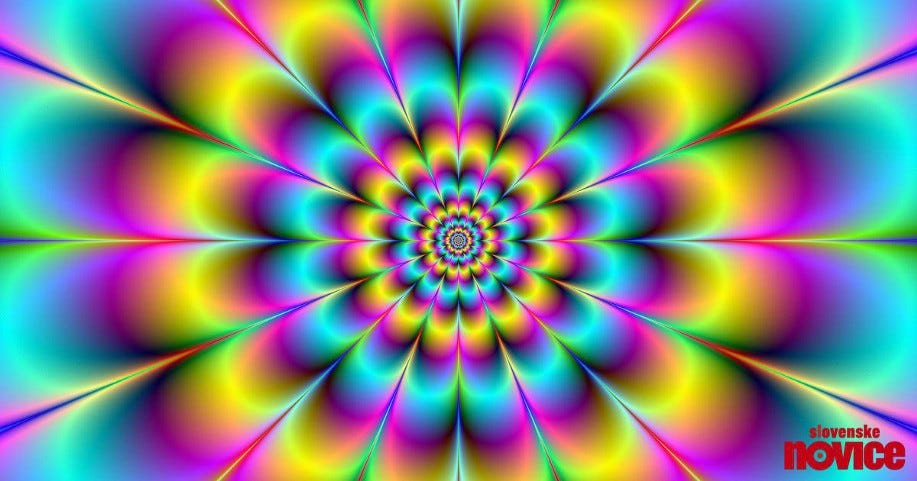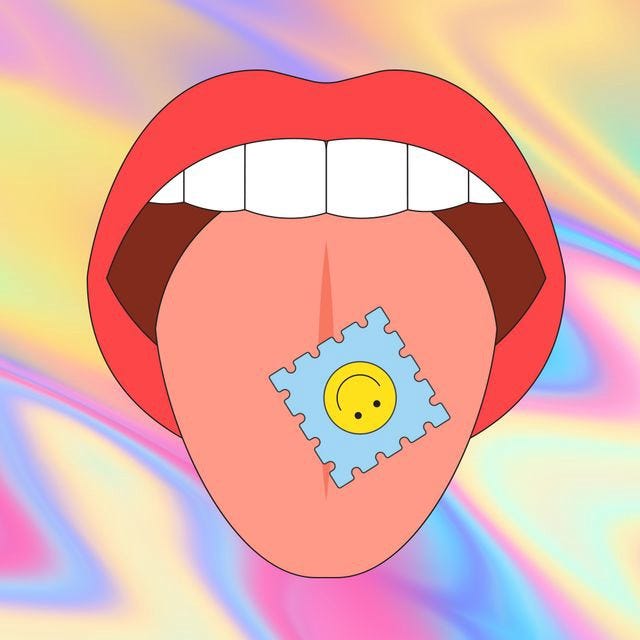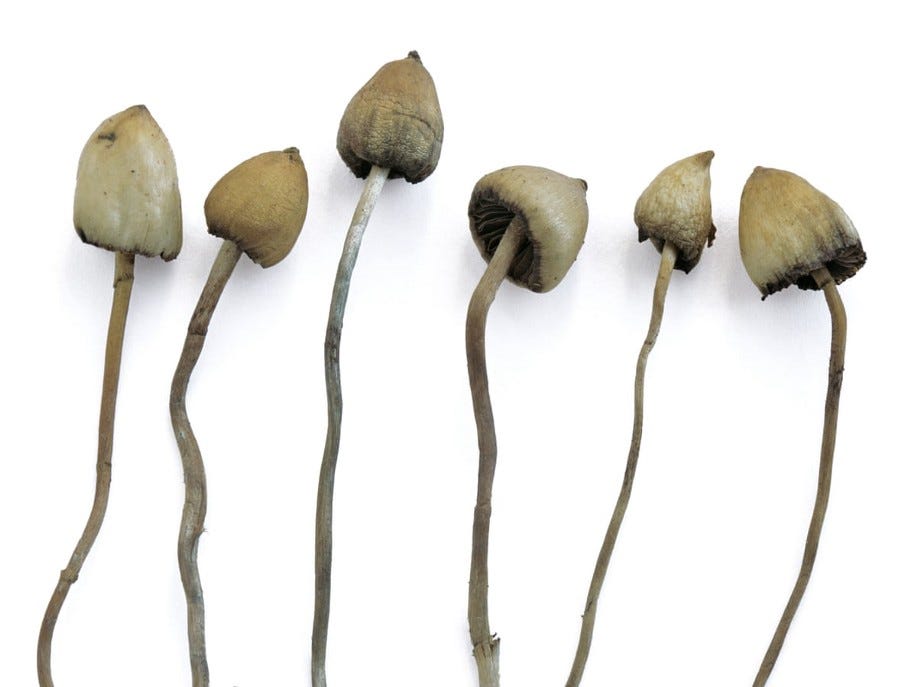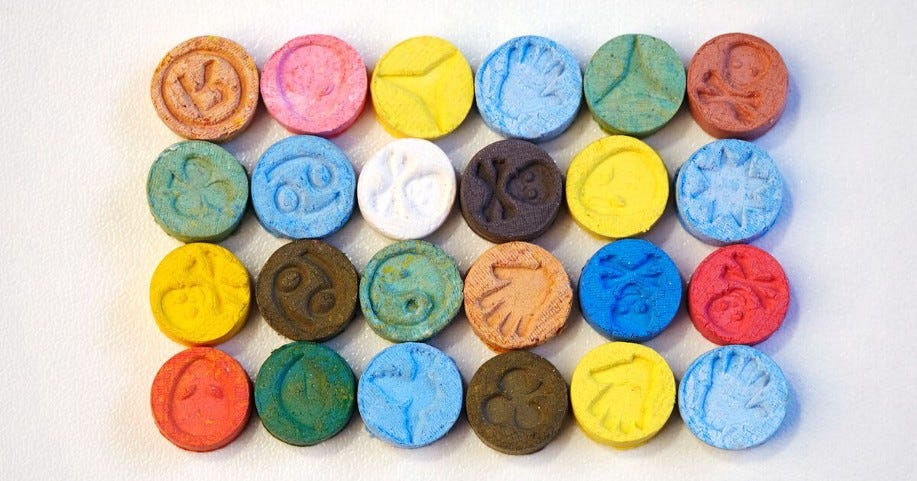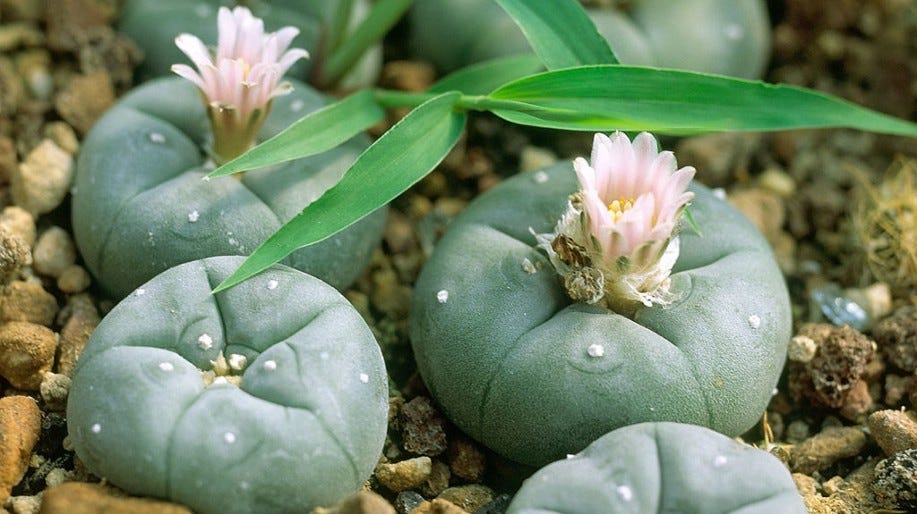If you haven’t watched the new Netflix documentary series called How To Change Your Mind, I highly recommend it.
The documentary series is based on Michael Polland’s best selling book How to Change Your Mind: What the New Science of Psychedelics Teaches Us About Consciousness, Dying, Addiction, Depression, and Transcendence
If you’re familiar with the benefits of psychedelic substances — LSD, psilocybin, MDMA, ayahuasca, DMT, … — you will enjoy it and might learn something new — like I did.
If you’re not familiar with these “mind-altering” substances or still have any prejudice about them, this documentary series will probably change your mind about them — or at least make you rethink your own beliefs about them.
In this article I’m going to talk theabout new Netflix series How To Change Your Mind, the four psychedelic substances that it encompases, their benefits on mental health problems and healing and my thoughts about psychedelics and whether or not you should take them.
About How To Change Your Mind
The series explores how psychoactive substances can have a profound impact on our health and consciousness when used in clinical or traditional ceremonial settings.
Psychedelics can help not only mental problems such as PTSD (Post Traumatic Stress Disorder), OCD (Obsessive Compulsive Disorder), eating disorders such as anorexia nervosa, anxiety and depression, but can also help and cure alcoholism and addiction.
They can help people deal with the fear of death and cancer, help people change their thinking patterns and beliefs system, and see things and problems in a different way and find new creative solutions to old problems.
These psychoactive substances also help us broaden our awareness and expand our consciousness and thus help us be happier.
Oftentimes using these substances can also have spiritual and transcendent experiences that can on its own radically change your life.
What are “Psychedelics”?
In the series MIchael Pollan, the author of the book, narrator and protagonist goes on a journey of exploring psychoactive substances — Psychedelics.
He starts with a traditional tobacco ceremony with a “ceremonial leader’’ and then goes on with exploration of LSD, psilocybin, MDMA and mescaline.
The word Psychedelic was conceived by Humphry Osmond and Aldous Huxley and means “mind manifesting” and encompasses a class of hallucinogenic drugs whose primary effect is to trigger non-ordinary states of consciousness — also known as psychedelic experiences or “trips”.
“We’ve all heard really scary things about psychedelics. They scrambled your chromosomes. They caused you to hop off of buildings and think you could fly. It was all terrifying. People dying. People going crazy. And I believed it all.” Pollan summarized the common beliefs about psychedelics that have been going on since the mid 1960s.
So Pollan took a look at the true effects of these substances, started researching them and was very surprised at what he found.
Contrary to popular belief, Pollan through his research discovered that “these are not addictive drugs and they are remarkably non-toxic.”
Although there might be some risks for people who are vulnerable or disposed to serious forms of mental illness — eg. schizophrenia can trigger psychotic break — Pollan believes that these psychedelic substances are “the tool for understanding the mind.”
The Plot
Series consists of four episodes, each discussing and exploring one of these “classical” psychedelics that have the largest scientific and cultural influence: LSD, Psilocybin mushrooms, MDMA and mescaline.
Each episodes explores the history behind each of the substance, why they got forbidden, their usage and treatment of mental problems such as PTSD (Post Traumatic Stress Disorder), OCD (Obsessive Compulsive Disorder), alcoholism and addiction, eating disorders such as anorexia nervosa, anxiety and depression, and other health condition and problems.
Spoiler Alert: Below is a brief summary of each episode of the series. If you’re intrigued to watch the whole documentary series and don’t want to be spoiled any details, skip this part to Final Thoughts.
1. Ergot or LSD
Before psychedelics were banned and classified as Schedule I drugs in late 1960s, there was a long “pre-60s history”, from 1950 to 1965, which was a “remarkably fertile period of research about psychoactive and psychedelic substances, specifically into LSD.”
Pollan says that “LSD was really considered a miracle drug.”
LSD was discovered in 1938 by Albert Hoffman, Swiss scientist working for Sandoz laboratories. Later on Hoffman accidently ingested some LSD and had a profound “spiritual” and “mystical” experience on the ride home on his bicycle. Although he described the experience as “very hard and challenging” and he thought that this might be the end for him, his psychedelic experience was also visually and sensibly very beautiful. Hoffman also reported that the next day when he woke up, it was like he was starting a new life: that he was born again.
But because in the mid 1960s the use of LSD started to spread rapidly, the govern body became afraid of the opening of the “consciousness” amongst the population and afraid of potential rebellions, especially against the Afghanistan War, they started the so-called “War on Drugs” and banned all the psychedelic substances, including LSD. With this, medical research with psychedelics stopped as well.
It wasn’t until the early 2000s that the research slowly began to pick back up. The Swiss Government allowed the LSD protocol for a study for treating people who suffer from severe physical and mental conditions caused by cancer.
Through the episode, we learn about many benefits that LSD can have when used in clinical or traditional ceremonial settings.
Benefits of LSD include:
Alcoholism: LSD can treat and cure various stages of alcoholism,
Creativity: using LSD many people found a solution to the problem that had been stuck with for over 3 months,
Progress in society: LSD is credited to have helped scientists and innovators with new discoveries: eg. discovery of DNA, the first earth shot, invention of modern computers, etc.
Health problems: LSD can treat and cure various health problems and disease, including anxiety, depression, pain, cancer, cluster headaches, etc.
Microdosing benefits: Microdosing LSD can help with and even cure depression, bipolar disorder and other mental health benefits.
2. Psilocybin Mushrooms
The first known culture to have used psilocybin mushrooms — today known as “magic mushrooms — were the Mazatec Indians, the indigineus people of Mexico, 400 years ago.
Spanish conquistadors talked about people using mushrooms and entering these transcendent states of consciousness. That was scary for the Chatolic church, so they banned the mushrooms and they went underground where the traditional ceremonies using psilocybin mushrooms have been preserved.
Psilocybin mushrooms started to emerge to the Western Society in the late 1950s. Around 1960 Alber Hoffman, the inventor of LSD, got his hands on some psilocybin mushroom, analyzed it, named the chemical psilocin and synthesized it for the first time.
In the 1970s psilocybin mushrooms were used in clinical settings with patients who were dealing with cancer and they were very effective in lifting up people’s fear of death and easing the physical, emotional and psychological symptoms and suffering from cancer.
But then Nixon’s war on drugs came.
As Pollan explains, “Despite the remarkable outcomes with patients, in the 1970s psilocybin became a Schedule I substance, classified as a dangerous drug with no medical use.”
The renaissance started at the turn of the millennium with trying to bring psilocybin mushrooms back as a legitimate medicine. The first study happened in 1997 at the Johns Hopkins Hospital to study psilocybin at a quite high dose in healthy volunteers who have never before had a psychedelic drug.
Through the episode, we learn about many benefits that psilocybin mushrooms can have when used in clinical or traditional ceremonial settings.
Benefits of psilocybin include:
Improves the quality of life
Changes and expands human consciousness
Eases the physical, emotional and psychological symptoms and suffering from diseases and conditions
One treatment cures fear of death with cancer patients
One treatment helps with, even cures, addiction and alcoholism, OCD (Obsessive-Compulsive Disorder), anorexia nervosa, anxiety and depression
Cures OCD in one session
Changes the stories and belief system that we have about ourselves
Can make people more creative
Creates one of the most meaningful experience in people’s lives
3. Ecstasy or MDMA
As Pollan describes, MDMA’s got “this weird history that doesn’t exactly parallel psychedelic history.”
It was patented in 1912 by Merck, one of the leading pharmaceutical companies, when researchers were looking for a blood-clotting agent, but “sat on the shelf until the 1970s” when Sasha Shulgin synthesized it. Then Leo Zeff was the first psychotherapist who started to use MDMA in his psychiatric practices and then highly used in therapy settings until 1985
But as other psychedelics, MDMA too entered the counterculture in the 1980s as ecstasy and was sold widely which caused the government body to place it under emergency control and Schedule I Drugs.
Dr. Rick Doblin started an FDA strategy to make MDMA a medicine for treatment in medical and psychotherapeutic settings and after 37 years MDMA now stands poised to become the first of this group of banned drugs to be legalized to use in assisted psychotherapy treatment.
Through the episode, we learn about many benefits that MDMA can have when used in clinical or traditional ceremonial settings.
Benefits of MDMA include:
healing different kinds of trauma: war trauma, sexual trauma, because MDMA treats the root cause and not the symptoms
in ⅔ of cases, MDMA cures PTSD (Post Traumatic Stress Disorder) caused by stressful events and trauma (soldiers in war, natural disaster, rape and abuse, death of loved ones,
allows you a powerful insight into yourself and see who you are without self-rejection
experience life and love of everyday life more deeply, deep connection to ourselves, others, nature and everything
access to our own innate healing capacity
it allows you to go to those dark, difficult, forbidden, avoidant memories that you wouldn’t be able to touch
allows you to switch off fear and pain because MDMA turns off the amygdala
cures very strong addiction to alcohol and opioids (like heroin)
4. Peyote or Mescaline
MIchael Pollan considers Peyote “an orphan of psychedelics” since “you can read a lot about it in history, but not much about it in the present.”
Peote is a chemical compound, a phenethylamine, which is like MDMA, and is produced in two classes of cactus that we know about:
one is Peyote cactus that grows in both sides of the Rio Grande River in Mexico and the United States
the second is San Pedro cactus called Huachuma, native to the Andes.
Peyote has been part of the sacred Church ceremony in Native American tribes and people to heal a sick person with this holy medicine and connect to the earth and the Universe, to get closer to God.
When the Conquistadors got to the Americas in 1492, they wanted to destroy the native culture — and that included this psychedelic medicine.
Since peyote had been part of their Native American religious worship and gave people “access to God’’, which the Chatolic church didn’t like because they felt like it threatened their church and faith. So the Spanish tried to suppress the use of this psychedelic and wiped it out in 1620. But the intent to wipe out peyote didn’t succeed: indiginous people preserved it.
Peyote survived “underground” but was then swept up in the drug war and put into Schedule I Drugs with no medical use, but then in 1994 it was allowed and protected as a sacrament in Native American Church.
Through the episode, we learn about many benefits that peyote can have when used in traditional ceremonial settings.
Benefits of peyote include:
individual healing: can addiction, depression, anxiety, healing the trauma, emotional states, spirits
collective healing: healing collective trauma: eg. healing the collective trauma of the repression that the Native Americans experience in the past.
connect to the earth and the Universe and to get closer to God.
Final Thoughts
Regardless of all the positive effects and healing that psychedelics bring, these substances are to be treated respectfully and are not to be played with: so-called “Bad Trips” are not that rare and can be very challenging experiences.
If you underestimate these substances, you might end up having a “bad trip”: you will regret taking them, you’ll end up resenting them, which will deter you from using them in the future and cause you to miss potential opportunities to heal and become better as a person.
So if you would like to explore these substances and you don’t have any experience, the best and the most safe way to do it would be with a guided setting.
Experts believe that the great contribution to psychedelic healing is the concept of “Set and Setting”. Your internal and external shape the experience: the kind of psychedelic experience you will have will be strongly influenced by the setting in which you have it and your set — your mindset.
“In a situation where you’re being guided, you’re in a very safe environment. You have kind of optimized everything we’ve learned about psychedelics into a set of practices and instructions that minimizes the chance of anything bad happening.” suggest Michael Pollan.
So instead of buying some magical mushrooms and doing a “trip” on your own, explore options around you: there might be some centers and organizations that offer legal ceremonies using LSD, psilocybin, MDMA or Ayahuasca.
Whether you’re suffering from any chronic mental health condition, remember: The cure is never and within reach!
Next week I will share with you my own experiences with psychedelics and how they have helped me with burnout — my own “chronic” condition.
If you enjoyed this article, share it with those you think will benefit from it.
If you have a question, an idea for a topic and suggestions, use the form linked below and I will answer it in next newsletters.
You can also follow me on social media for more tips, content and insights about burnout awareness, prevention and treatment.
I keep this newsletter free so I can help more people. If you like my work and you want to support me, you can donate. I'll be grateful from the bottom of my heart!
Love and take care of yourself, forget about worries and enjoy life! ✌
~ Jani ❤

